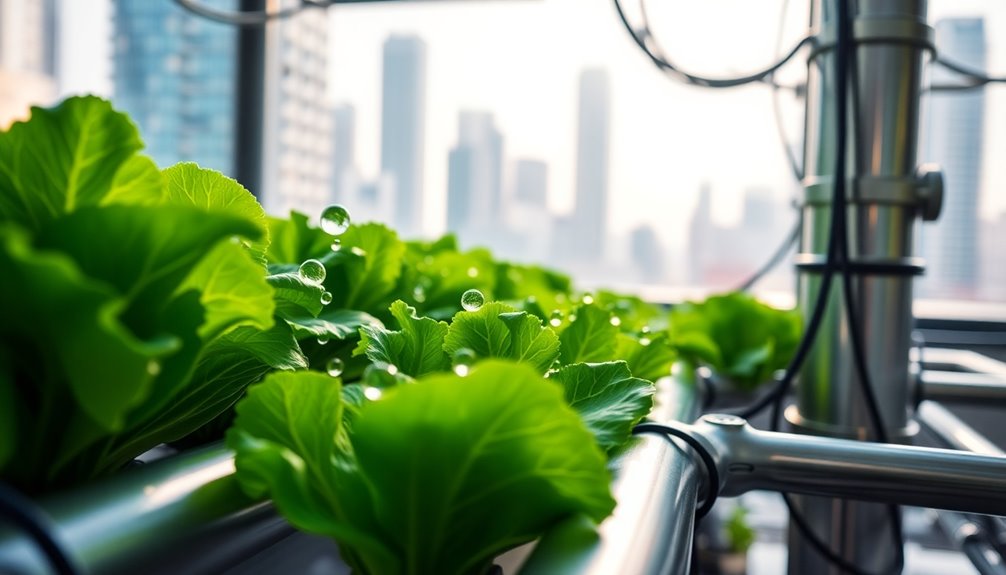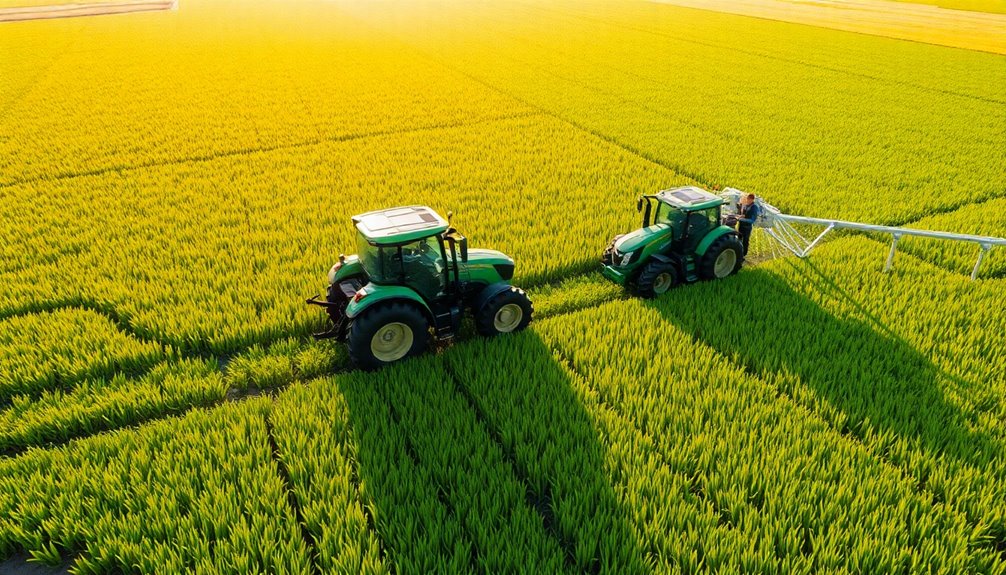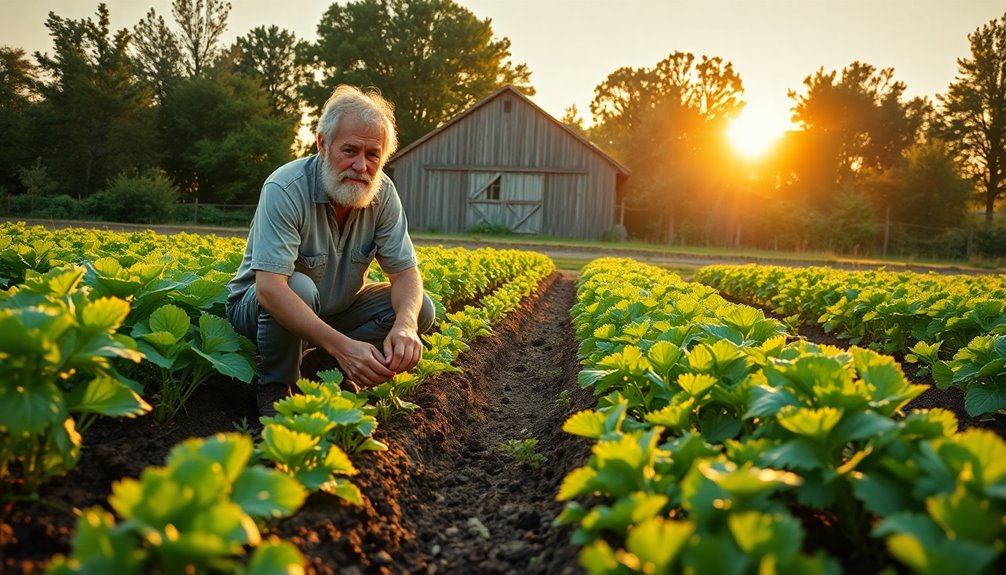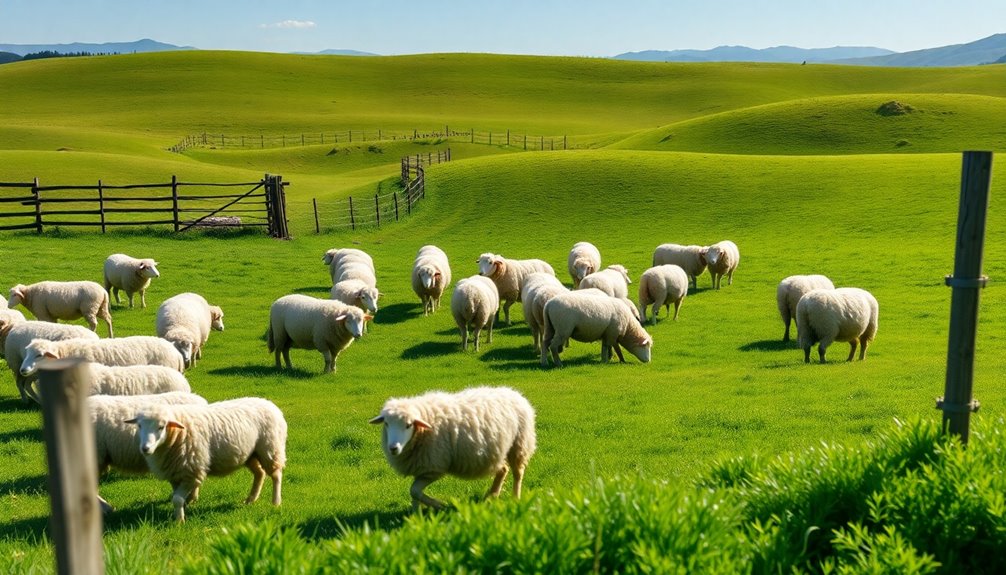Hydroponic farming lets you grow plants without soil, using nutrient-rich water solutions instead. You'll find this innovative method offers precise control over factors like temperature and lighting, allowing for higher yields and faster growth. Various systems cater to different plants, making it versatile for any gardener. Hydroponics uses up to 90% less water than traditional methods, making it a sustainable choice for the future. As technology advances, hydroponics is set to play a key role in urban agriculture and food security. Keep exploring to discover how this soil-free farming is shaping the future of agriculture.
Key Takeaways
- Hydroponic farming cultivates plants in nutrient-rich water, eliminating the need for soil and allowing for precise environmental control.
- Various hydroponic systems, like NFT and Ebb and Flow, cater to diverse plant growth requirements and optimize resource use.
- This method uses up to 90% less water than traditional farming, making it ideal for water-scarce regions and promoting sustainability.
- Hydroponics offers year-round crop production with higher yields and reduced reliance on harmful pesticides, enhancing food quality and security.
- Future trends include automation and AI integration, which will lower labor costs and improve efficiency in hydroponic systems, contributing to local economies.
Definition of Hydroponic Farming
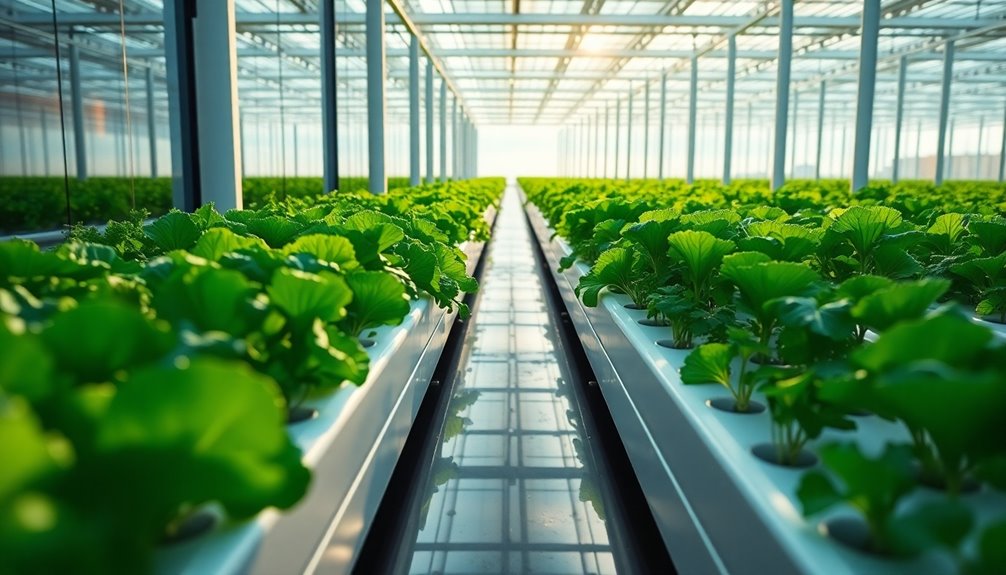
Hydroponic farming, at its core, is a method of growing plants without soil. Instead, it uses a nutrient-rich water-based solution to deliver essential nutrients directly to the plant roots.
This soilless system allows you to precisely control environmental factors like temperature, humidity, and lighting, optimizing growth conditions. You can support plant roots with inert media such as perlite or rock wool, ensuring stability. Additionally, hydroponics offers the advantage of efficient use of water and nutrients, which is crucial for sustainable farming practices.
Hydroponics includes various systems like Nutrient Film Technique and Ebb and Flow, catering to different needs. The recirculating system lets you reuse nutrients, minimizing waste.
With hydroponics, you can achieve year-round harvests and reduce water consumption while enjoying optimal space utilization, making it a sustainable choice for modern agriculture.
History of Hydroponics
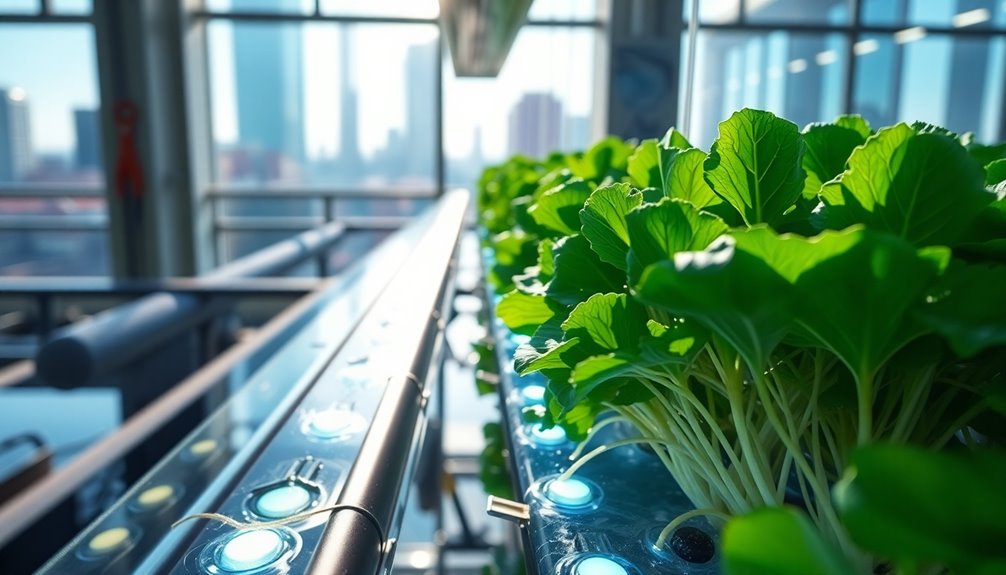
The practice of growing plants without soil has roots that stretch back thousands of years, showcasing humanity's ingenuity in agriculture.
The Hanging Gardens of Babylon, around 500 B.C., featured a remarkable water-based system, while ancient Chinese farmers utilized hydroponic methods for rice cultivation by 1000 A.D.
By 1627, Sir Francis Bacon explored soil-free growing, paving the way for modern practices.
In the late 1800s, researchers identified essential nutrients for plants, leading to solution culture.
Fast forward to 1929, and William Frederick Gericke demonstrated the potential of hydroponics at UC Berkeley.
By 1937, he coined the term "hydroponics," marking a significant milestone in its history. This foundation set the stage for today's innovative, efficient agricultural practices, contributing to the fact that 90% of lettuce and tomatoes in the U.S. and Canada are grown hydroponically.
Types of Hydroponic Systems
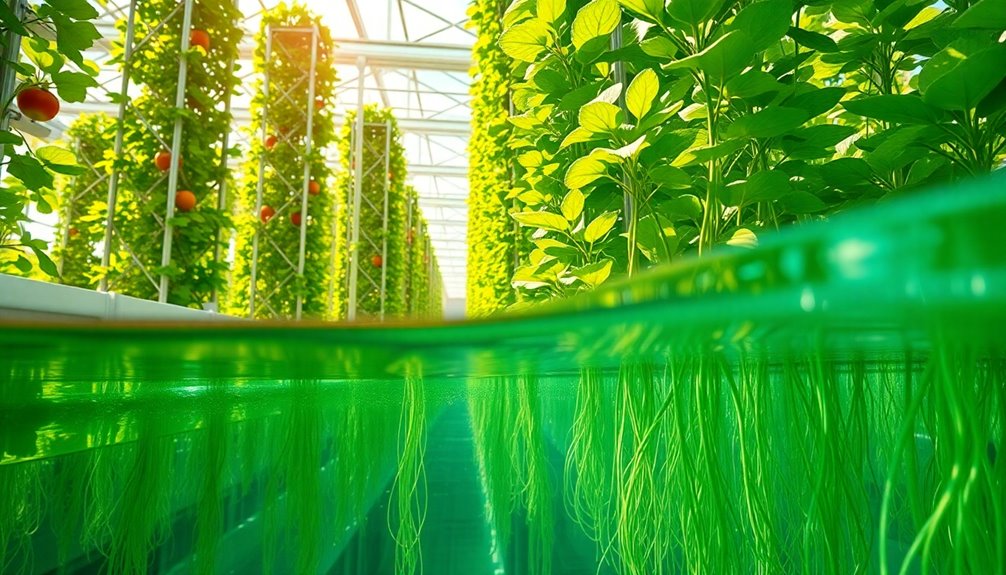
Numerous hydroponic systems exist, each designed to optimize plant growth while minimizing resource use.
One popular method is the Nutrient Film Technique (NFT), where plants grow in net pots with roots in a continuously flooded channel of nutrient solution, perfect for fast-growing crops like lettuce.
The Ebb and Flow system periodically floods a growing medium and drains, accommodating larger plants like tomatoes. Ebb and Flow systems are particularly effective due to their customizable tray sizes, allowing for versatile planting options.
Drip Irrigation delivers nutrients directly to the growing medium, but keep an eye out for clogs.
Aeroponics suspends plants in air, misting their roots for rapid growth.
Additionally, systems like Deep Water Culture and wick systems offer unique ways to deliver nutrients and oxygen, ensuring your plants thrive without soil.
Benefits of Hydroponic Farming
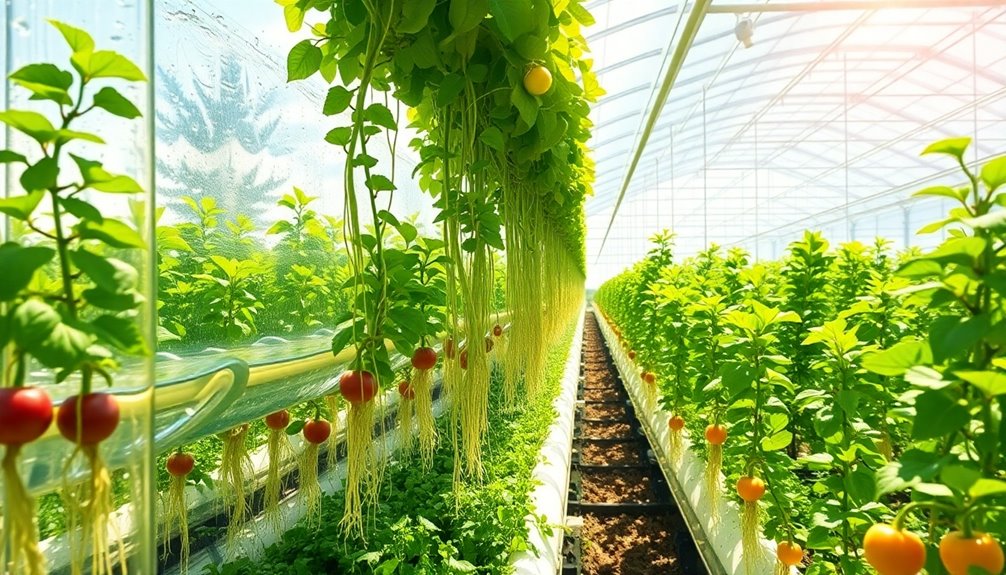
When exploring various hydroponic systems, it's clear that the advantages of hydroponic farming extend far beyond just innovative growing techniques.
You'll find that it uses up to 90% less water than traditional agriculture, with closed-loop systems capturing and recycling water efficiently. This makes it a viable option in water-scarce areas. Additionally, hydroponic farming allows for higher plant densities, leading to increased yields per square foot and faster growth rates. You can grow crops year-round, regardless of seasonal changes. Hydroponics utilizes controlled environments to minimize contamination risks and enhance crop quality.
Space efficiency is another perk, as vertical systems optimize urban settings. Plus, with reduced chemical use and lower pest risks, you can produce high-quality food free from harmful substances, ensuring healthier choices for you and your community.
Environmental Advantages
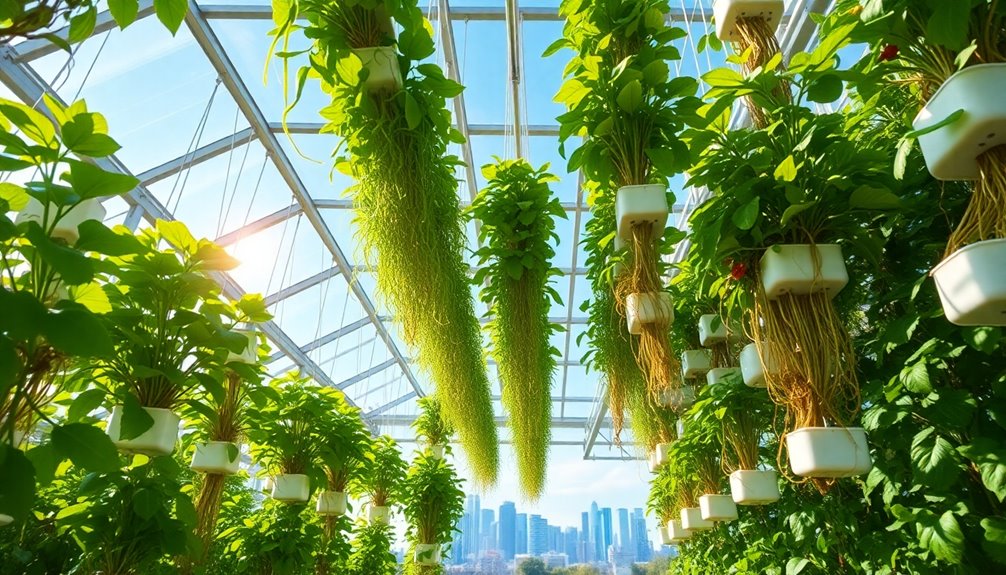
While hydroponic farming offers innovative growing techniques, its environmental advantages are equally compelling.
You'll find that it uses significantly less water than traditional farming, conserving 90 to 95% and recycling water effectively, which minimizes loss. With only about 1.5% water loss per day, it eliminates the run-off and evaporation issues common in outdoor settings.
Moreover, hydroponics doesn't degrade or erode soil, allowing you to farm in areas with poor soil quality. Additionally, hydroponic systems can lead to sustainable water management practices that help mitigate water contamination issues.
You can also say goodbye to harmful pesticides and fertilizers, as these systems rely on water-based nutrient solutions. This not only enhances food safety but also reduces chemical contamination in water sources.
All this adds up to a more sustainable approach to agriculture that you can feel good about.
Challenges and Disadvantages
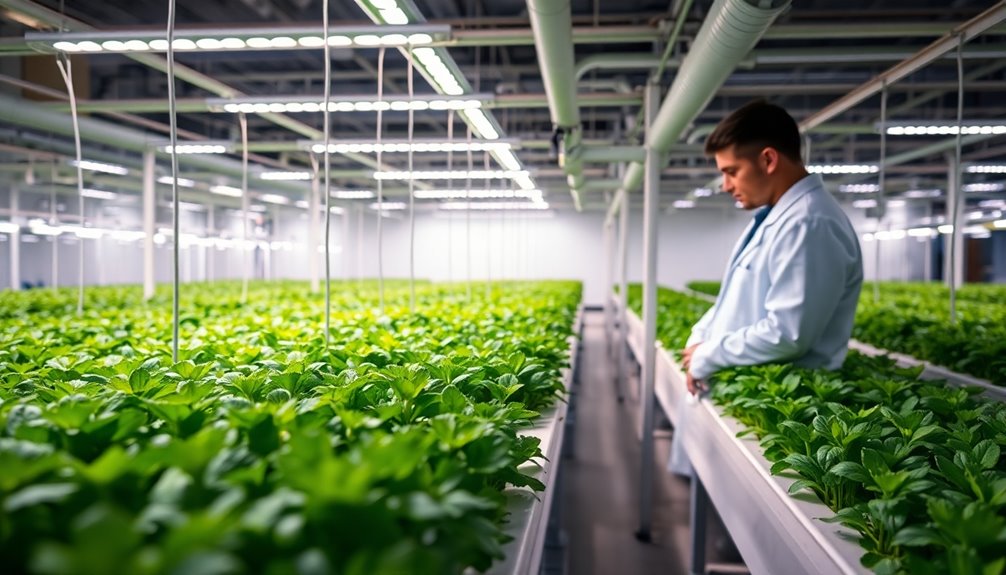
Despite the numerous environmental advantages hydroponic farming brings, it also comes with its share of challenges and disadvantages. One major hurdle is the high initial cost of setting up a hydroponic system, which includes infrastructure like grow lights and pumps. This investment can be a significant barrier for small-scale or home growers.
Additionally, your system relies heavily on electricity, making it vulnerable to power outages that could harm your plants. Maintenance is another concern, as it requires constant monitoring of nutrient solutions and environmental conditions, which can be time-consuming. Moreover, hydroponics systems often achieve higher yields due to optimized conditions, but this can also lead to increased complexity in managing nutrient levels.
Lastly, disease management can be tricky, with higher risks of waterborne diseases and nutrient imbalances, demanding integrated pest management strategies to keep everything in check.
Technological Innovations
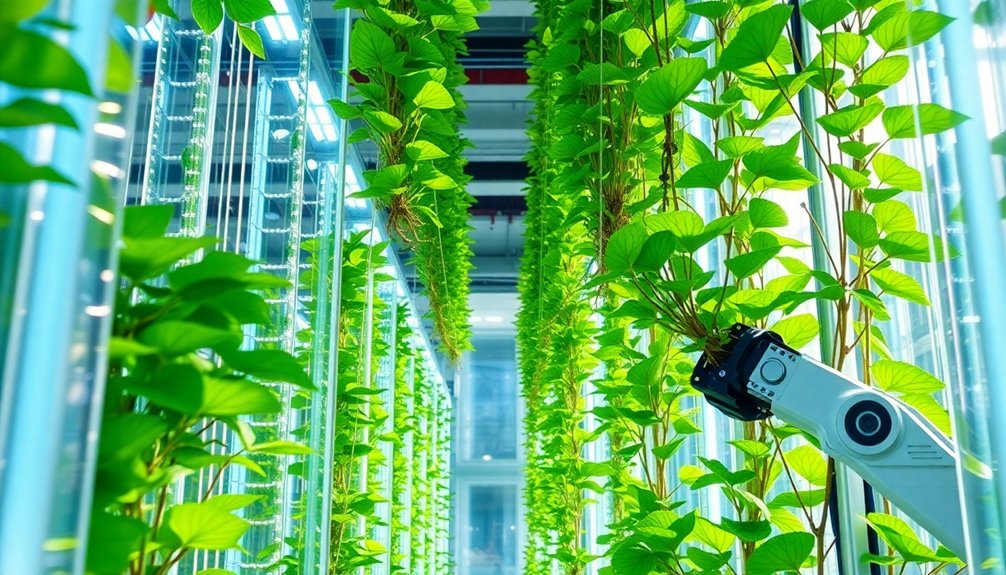
Technological innovations are revolutionizing hydroponic farming, making it more efficient and accessible than ever.
You can now leverage AI and machine learning to optimize plant growth conditions by adjusting light intensity, nutrient concentration, and pH levels based on real-time data. This helps maximize yield while minimizing resource usage.
IoT devices enable you to monitor and control your hydroponic systems remotely, ensuring nutrient delivery aligns with plant needs. IoT-enabled hydroponics enhances overall operational effectiveness by consolidating and analyzing data across multiple systems.
Automation reduces manual labor, allowing precise adjustments of environmental parameters, and smart hydroponic systems manage nutrient dosing accurately.
Additionally, LED grow lights simulate sunlight and can be customized to influence plant behaviors, significantly improving plant health and yield.
With these innovations, you're equipped to thrive in the future of agriculture.
Nutrient Management
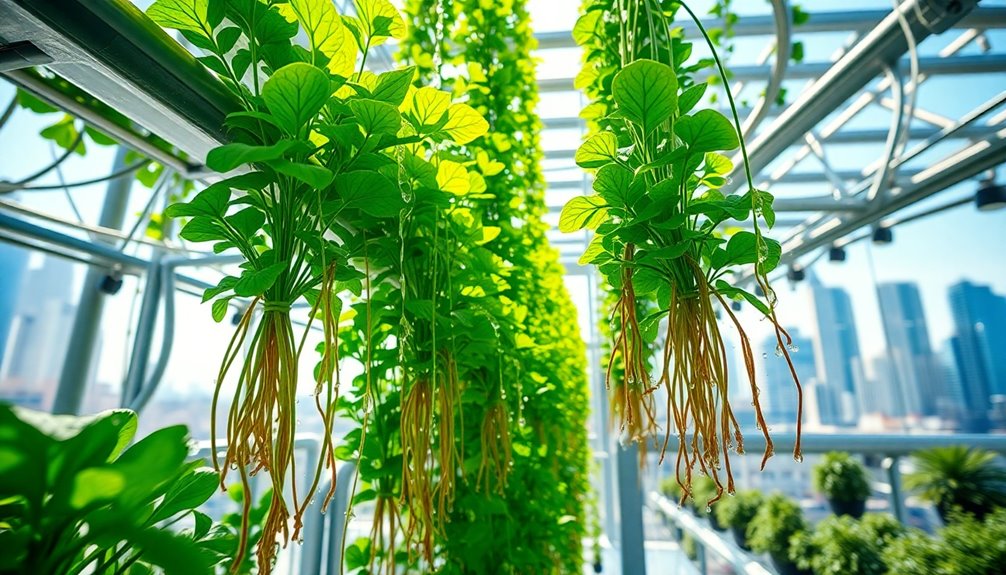
Understanding nutrient management is crucial for successful hydroponic farming.
You'll need to focus on primary macronutrients like nitrogen, phosphorus, and potassium to support growth, root development, and overall health.
Secondary nutrients such as calcium, magnesium, and sulfur also play essential roles.
Don't forget micronutrients like iron, manganese, and zinc, which are vital in smaller amounts.
Balancing your nutrient solutions is key; commercially available mixes can simplify this process.
Regularly test your solution's pH and electrical conductivity (EC) to ensure nutrients are available.
Adjust based on your plants' growth stages—seedlings need less, while mature plants require more, especially phosphorus and potassium.
Monitoring nutrient levels is essential to prevent issues like toxicity and nutrient deficiencies.
Monitor plant responses for feedback on your nutrient management effectiveness, making adjustments as necessary to optimize health.
Future of Hydroponics
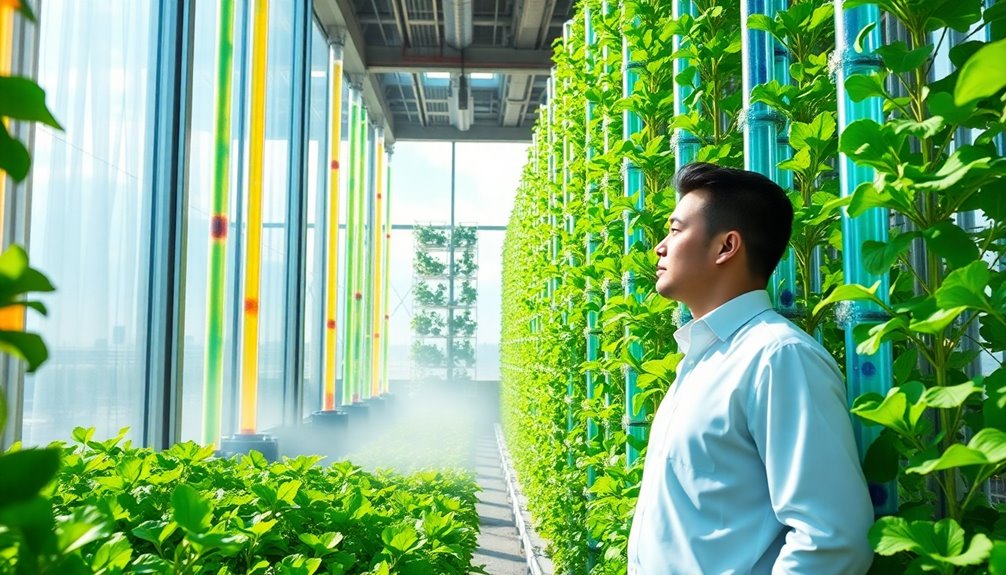
As hydroponics continues to evolve, innovative technologies and sustainable practices are shaping its future in remarkable ways.
You'll notice automation and AI becoming integral to hydroponic systems, drastically reducing labor costs while optimizing resource allocation. Automated seeding and harvesting streamline operations, while AI enhances nutrient formulation and pest detection.
The market's growth is impressive, projected to reach USD 5 billion in 2023 and growing at 12.4% CAGR through 2030. This growth is fueled by the many benefits of hydroponics, including its water efficiency, which uses up to 98% less water than traditional farming methods.
You'll also see hydroponics becoming crucial for water conservation, especially in areas facing scarcity. Moreover, its adaptability in urban settings and extreme climates expands its application.
With the potential for year-round cultivation, hydroponics is set to revolutionize agriculture and contribute significantly to global food security.
Hydroponics in Urban Agriculture
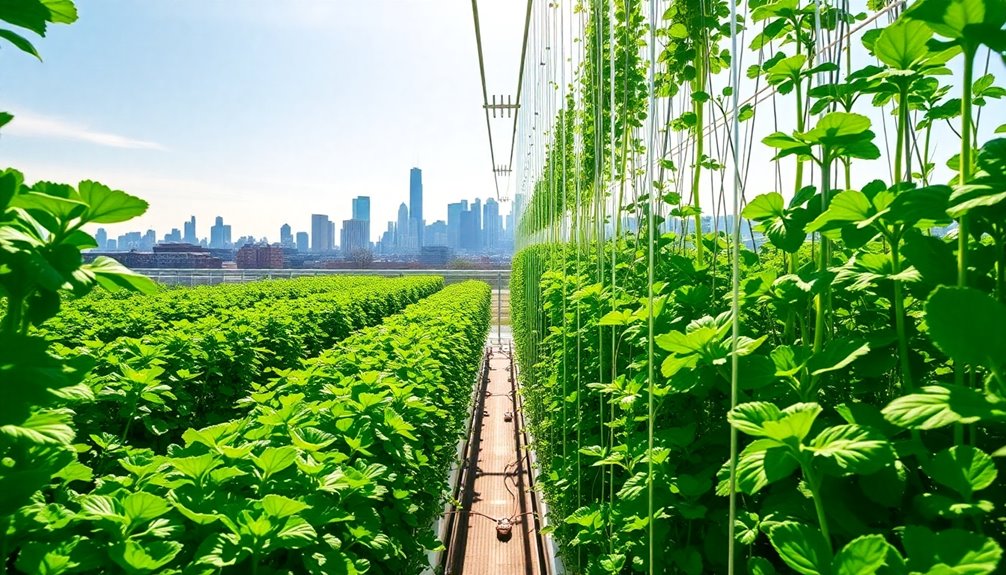
Hydroponics is rapidly becoming a game-changer in urban agriculture, addressing the unique challenges cities face.
With its ability to use up to 90% less water, you can grow fresh produce even in water-scarce environments. Hydroponics maximizes space through vertical farming, making it perfect for utilizing abandoned buildings and rooftops.
You can enjoy year-round crop production thanks to climate control, while also reducing reliance on harmful pesticides. Increased yields and faster growth rates mean you can provide local communities with fresher food, enhancing food security. Additionally, hydroponics significantly reduces pest impact, leading to healthier crops with less need for chemical interventions.
Plus, engaging in hydroponic farming helps empower your community and boosts the local economy. It's a sustainable solution that transforms urban landscapes into productive agricultural hubs.
Frequently Asked Questions
What Crops Are Best Suited for Hydroponic Farming?
When choosing crops for hydroponic farming, focus on high-demand options like leafy greens, herbs, and strawberries.
These plants not only thrive in limited space but also provide quick yields.
Consider tomatoes for their rapid growth and substantial harvests.
Ensure you select crops with similar nutrient needs for easier management.
Lastly, think about the specific hydroponic system you're using, as it can affect which crops will flourish best in your setup.
How Much Space Is Needed for a Hydroponic System?
To determine how much space you need for a hydroponic system, assess your desired crop yield and the size of each plant.
Use size charts to plan your layout, ensuring adequate room for growth.
Consider vertical arrangements to maximize space, especially in compact areas.
If you're growing larger plants, opt for systems that accommodate their root space and light needs.
Can Hydroponics Be Done at Home?
Yes, you can absolutely set up hydroponics at home!
Start by choosing the right space, whether it's a balcony or a corner in your kitchen. Select a system that fits your needs, like NFT or Ebb and Flow.
Gather supplies like growing mediums and nutrient solutions. Once you build your system, maintain it by testing pH levels and checking for leaks regularly.
You'll enjoy fresh produce right from your own home!
What Are the Costs Associated With Hydroponic Farming?
When you're considering hydroponic farming, you'll encounter several costs.
Initial setup can range from $500 for small systems to over $100,000 for commercial setups, depending on equipment and complexity.
Ongoing expenses include nutrients, energy, labor, and maintenance, which can add up significantly.
However, employing cost-saving strategies, like water and energy efficiency, can enhance your profitability.
With higher yields and faster harvest cycles, investing in hydroponics can lead to substantial returns.
How Does Hydroponics Compare to Aquaponics?
When you compare hydroponics to aquaponics, you'll find distinct differences.
Hydroponics uses synthetic nutrients and demands regular testing, giving you precise control over nutrient levels.
On the other hand, aquaponics relies on fish waste, creating a natural cycle.
While both methods conserve water and boost plant growth, aquaponics tends to be more sustainable and cost-effective in the long run.
Conclusion
In conclusion, hydroponic farming presents a promising future for soil-free agriculture. By embracing this innovative method, you can enjoy fresher produce, conserve water, and reduce the need for harmful pesticides. As technology continues to advance, the potential for urban agriculture grows, making fresh food accessible to more people. So, whether you're a seasoned grower or just starting out, hydroponics offers exciting opportunities for sustainable farming that benefits both you and the planet.

